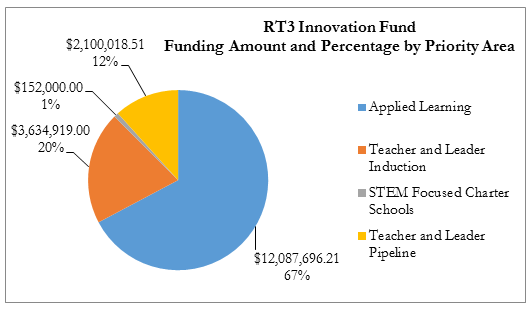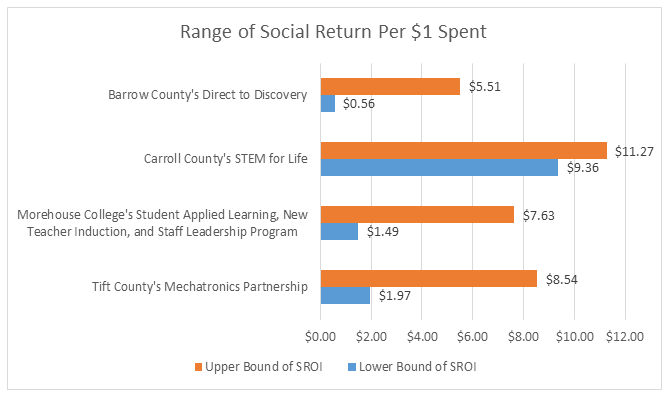
What Have We Learned from the Race to the Top Innovation Fund?
June 29, 2015
In 2010, Georgia created the Innovation Fund with $19.4 million from its four-year Race to the Top (RT3) federal grant. Administered through the Governor’s Office of Student Achievement (GOSA), the Innovation Fund has provided competitive grants to eligible organizations – including local education authorities (LEAs), traditional public schools, charter schools, nonprofit organizations, and institutions of higher education (IHEs) partnering with K-12 schools and districts – interested in planning, implementing, and scaling innovative education programs that advance student achievement throughout Georgia.

Using three rounds of funding, Governor Deal awarded 23 grants, totaling $17,974,633.72. Twenty of the grants were implementation grants, and three were planning grants. Twelve grants funded K-12 STEM-focused applied learning programs, and eight grants funded teacher and leader induction or pipeline programs. Table 1 below provides a breakdown of funding by priority area.
This education update summarizes two reports that GOSA used to evaluate the efforts of Innovation Fund grantees and disseminate data to the public: The Race to the Top Innovation Fund Report and the Social Return on Investment study.
The Race to the Top Innovation Fund Report
On June 9, 2015, GOSA published The Race to the Top Innovation Fund Report. The report provides a comprehensive look at the groundbreaking education programs that were implemented in Georgia through the Race to the Top federal grant. It utilizes a vignette style that, for each program, provides first-hand perspectives of daily activities, describes the origin and design, and analyzes quantitative and qualitative outcomes. In addition, each vignette concludes with lessons learned and best practices that can be applied in education programs throughout the state.
The applied learning programs focused on the real-world application of STEM (Science, Technology, Engineering, and Math) knowledge. These grantees sought to ignite student interest in STEM subjects, leading to higher academic achievement and, post-graduation, the pursuit of STEM careers. Students in the applied learning programs were exposed to a breadth of applied learning experiences. For example, students in the Tift County Mechatronics Program applied their skills in a school and community repair clinic by fixing broken electronic items, including GPS systems, Xbox controllers, iPhones, baby monitors, and computers. Similarly, Real STEM high-school students attended Real STEM day at Georgia Southern, where they shared their course research in roundtable discussions and participated in college-level experiments with geology, engineering, mechatronics, and chemistry professors.
The induction/pipeline programs aim to improve teacher recruitment, retention, and professional development. These grantees implemented co-teaching programs, mentoring opportunities, new teacher residencies, and induction and orientation protocols designed to attract, cultivate, and retain the top talent in education. These programs also fostered supportive and collaborative environments ideal for new teachers and leaders. For example, teachers in Atlanta Neighborhood Charter School’s New Teacher Residency Program (ANCS NTRP) received support from over 45 veteran educators through Critical Friends Groups (CFGs) and mentoring. Principals in the University of Georgia/Georgia Association for Educational Leaders Early Career Principal Residency Program (UGA/GAEL ECRP) fostered an informal support network, providing them a unique opportunity to collaborate with principals throughout the state.
While each program has unique outcomes and lessons learned, overall students in the programs had statistically significant increases in intrinsic motivation, self-management/self-regulation, and intent to persist in STEM. In addition, most programs experienced gains in students’ EOCT and CRCT scores as well as graduation rates. Further, teacher/leader pipeline and induction programs fostered examples of job-embedded preparation from teachers and leaders, resulting in increased retention.
The Social Return on Investment Study
On June 5, 2015, GOSA published the results of a long-term social return on investment (SROI) study. GOSA contracted IMPAQ International (IMPAQ) to perform an SROI analysis of the Innovation Fund.
The SROI approach focuses on understanding what has changed as the result of a program, what matters to stakeholders about those changes, and the social value (value to stakeholders and society) of those changes. SROI studies involve stakeholders in a transparent process in which verifiable claims about value are founded on qualitative data (such as stakeholder interviews) and quantitative data (such as graduation rates), including financial information (such as program costs). The studies conclude by comparing the monetary value of outcomes to the original investment, thus determining a ratio of cost to value. In determining SROI, money is simply one way of conveying value.
The analysis focused on four programs:
- Barrow County’s Direct to Discovery, which provided innovative STEM applied learning to middle and high school students.
- Carroll County’s STEM for Life, which provided opportunities to apply STEM knowledge and skills in a real-world work setting.
- Morehouse College’s Student Applied Learning, New Teacher Induction, and Staff Leadership Program, which provided innovative STEM applied learning to high school students and professional development to teachers and leaders.
- Tift County’s Mechatronics Partnership, which provided high school students with a STEM applied learning program taught by technical college instructors.
IMPAQ and GOSA selected these programs for two reasons: 1) the programs clearly emphasize key components of the Innovation Fund’s Applied Learning priority (advanced coursework, connections to careers, and connections to higher education), and 2) they represent all high school applied learning grantees, and 3) they received their grants in the first two grant rounds, allowing for two to three years of data collection. As such, these four programs presented the most feasible means of gaining insight into the social return from Innovation Fund grantees.
IMPAQ ultimately identified a lower and upper bound of financial return on investment for each program. For all four programs, the highest-value outcomes were associated with a program’s influence on students’ postsecondary choices and the associated change in lifetime earnings. The upper bound, therefore, is primarily determined by applying the assumption that all those who intend to achieve a stated level of education will do so and thus reap the projected lifetime earnings linked to that degree or degrees. The lower bound is primarily determined by applying evidence-based data on acceptance and graduation rates, which winnows down the number of stakeholders expected to achieve their stated education goals. The SROI ranges are provided in the figure below. [1]

Students’ postsecondary plans had the greatest impact on the SROI ratio, leading IMPAQ to conclude that any program focusing on high school students, regardless of its other features and goals, should consider efforts to help students make postsecondary plans that are specific and ambitious, yet achievable. This will return more social value than any other single program component.
All SROI evaluations focus on understanding what happened in a given program, the outcomes resulting from its activities and changes, and the value derived from those outcomes. Stakeholder experiences are central the analysis. Nevertheless, this study of the Innovation Fund programs, like all SROI studies, produced a forecast of what will occur if the study’s predictions about future data prove correct.
The Future of the Innovation Fund
In his fiscal year 2015 budget, Governor Deal included $5 million in state funds to GOSA to continue the Innovation Fund work with additional grants. In December 2014, GOSA administered the first round of those grants to 18 applicants. The grants focused on planning, implementing or scaling programs aligned with the following priority areas: applied learning with a focus on STEM education, development and replication of blended learning school models, and teacher and leader induction and development.
GOSA has also released information about Fiscal Year 2016 Innovation Fund grant opportunities. The Governor appropriated state funding for the second consecutive year to provide new grant opportunities. The funding priorities for these future grants include:
- Applied Learning with a Focus on STEM (Science, Technology, Engineering and Mathematics) Education
- Birth to Age Eight Language and Literacy Development
- Development and Replication of Blended Learning School Models
- Teacher and Leader Development for High-Need Schools
Using state funding, the Innovation Fund will continue as a competitive grant program that supports local education authorities, schools, institutions of higher education, and nonprofit organizations in planning, implementing and scaling innovative programs.
[1] Although IMPAQ applied the same SROI methodology across the four studied programs and followed the same steps in building the final analysis, it cautions against comparing the SROI ranges program-to-program. Each program had specific goals and unfolded in specific contexts.